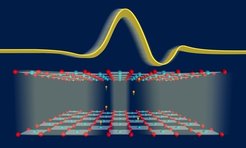Ultrafast switch for superconductors
Terahertz pulses control the lossless conduction of electricity
A high-temperature superconductor can now be switched on and off within a trillionth of a second – 100 years after the discovery of superconductivity and 25 years after the first high-temperature superconductor was. A team including physicists from the University of Oxford and the Max Planck Research Group for Structural Dynamics at the University of Hamburg has realised an ultrafast superconducting switch by using intense terahertz pulses. This experiment opens up the possibility to discover more about the still unsettled cause of this type of superconductivity, and also hints at possible applications for ultrafast electronics in the future.

Superconductivity is one of the most remarkable effects in physics. Every electrical conductor has a resistivity, but some materials lose their resistivity completely if they are cooled to below a characteristic temperature; the current then flows without any loss whatsoever. When the Dutch physicist Heike Kamerlingh Onnes discovered this effect in 1911 in mercury, he initially believed that his measuring instruments were faulty, before he became aware of the significance of his monumental discovery.
“Normal” conductors such as mercury or lead must be cooled down to temperatures near absolute zero at minus 273.16 degrees Celsius in order to become superconducting. It was therefore a sensation when, in 1986, Johannes Georg Bednorz and Karl Alexander Müller presented a ceramic material that already became superconducting at minus 248 degrees Celsius. Since then, these cold conductors have been a burning issue with both scientists working in basic research and users. The ultrafast switch, which has now been developed by the research group working with Andrea Cavalleri, head of the Max Planck Research Group for Structural Dynamics at the University of Hamburg, is a further astonishing discovery in this field.
The high-temperature superconductor used by the Hamburg scientists has been known for a long time. It is a crystal based on lanthanum cuprate (La2CuO4) to which a specific quantity of strontium has been added (La1,84Sr0,16CuO4). Its transition temperature is minus 233 degrees Celsius. Although it is not yet completely clear how the superconductivity arises here, essential elements are known: “The crystal is formed by copper-oxygen planes which lie on top of each other like the pages of a book,” explains Cavalleri. The electrons can only move within these planes; the current transport therefore only occurs in two dimensions.
If the material is cooled below 40 Kelvin, a link is suddenly created between these two planes. Physicists explain this using the wave model, according to which the electrons are pictured not as particles, but as waves. Below the transition temperature the electrons from neighbouring planes overlap, and this allows the electric charge carriers to change from one plane to the other. Current is suddenly transported in all three spatial dimensions: the superconducting state has been created.
A terahertz pulse briefly destroys the coupling of the electrons
Cavalleri and his colleagues then wanted to know whether this transport between the layers can be deliberately interrupted and switched on again. In theory this is possible if a very strong electric field is applied at right angles to the layers. However, applying such a field is impractical. “This causes the crystal to heat upand the superconductivity collapses,” explains Cavalleri. The solution was to send in an ultrashort pulse of light to manipulate the superconductor.
This so-called terahertz pulse is an electromagnetic wave, similar to light, but with a much longer wavelength. It has an electric field that briefly destroys the coupling of the electron waves between the planes when it penetrates into the crystal. This is only successful if the electric field strength of the pulse is very high, in the order of several ten thousand volts per centimetre. And it must be short enough that it does not heat up the crystal.
Only recently has it been possible to generate such extremely powerful, ultrashort terahertz pulses. This is the task of team member Matthias Hoffmann. In very simple terms, this is done by the interaction of an ultrashort laser pulse with a lithium niobate crystal. An effect which physicists call optical rectification then generates the desired terahertz radiation in the crystal.
The experiment, which Andreas Dienst designed and carried out in Oxford, succeeded as anticipated: for the short time of less than one picosecond (10-12 seconds) as the pulse interacts with the superconductor, the coupling between the planes, and thus the superconductivity, was interrupted before subsequently returning. The superconductor does not suffer in this process and can be switched as often as one likes.
“This is a very fascinating result, because we can also use this method to investigate how high-temperature superconductors work,” says Cavalleri. It is also possible that this effect additionally has real-world applications. Basically, the switchable high-temperature superconductor works in a very similar way to a conventional field-effect transistor. This is a semiconductor whose ability to pass a current can be controlled by applying an electric voltage. Analogous to this, is conceivable that the high-temperature superconductor could be used as an ultrafast, nanoelectronic transistor that is controlled by microwaves.
TB












